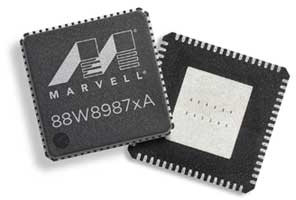Marvell has introduced the new 88W8987xA wireless chip with 802.11ac, 802.11p and Bluetooth 5 Connectivity for V2X (Vehicle-to-Everything) and IVI (In-Vehicle Infotainment) automotive applications such as Dedicated Short Range Communications (DSRC) systems, and secure wireless Gateway systems.
Key features of Marvell 88W8987xA family:
- Connectivity
- WiFI – IEEE 802.11ac (wave2) up to 433 Mbps / IEEE 802.11p WAVE (Wireless Access in Vehicular Environments) / 1609.x
- Bluetooth 5 including Bluetooth Low Energy Angle of Arrival and Departure (AoA/AoD)
- 2x antenna configuration for Wi-Fi/Bluetooth coexistence
- Host Interfaces – SDIO 3.0 interface (4-bit SDIO and 1-bit SDIO) @ up to 208 MHz; high-Speed UART interface (for Bluetooth only)
- Audio Interfaces – Digital audio interfaces (PCM)
- Temperature Range – -40°C to +105°C (AEC-Q100 Grade 2 Qualification)
- Package – pin 8×8 mm QFN with wettable flanks

The family now includes three pin-to-pin compatible SoCs:
- 88W8987A with 802.11ac + Qualified Bluetooth 5 Functionality
- 88W8987PA with 802.11p + Qualified Bluetooth 5 Functionality
- 88W8987SA with switchable 802.11ac/802.11p + Qualified Bluetooth 5 Functionality
The first time I read the SoC supported 802.11p, I though it might be a typo, but it’s just another WiFi standard specifically designed for automotive applications operating in the 5.9GHz range as explained on Wikipedia:
IEEE 802.11p is an approved amendment to the IEEE 802.11 standard to add wireless access in vehicular environments (WAVE), a vehicular communication system. It defines enhancements to 802.11 (the basis of products marketed as Wi-Fi) required to support Intelligent Transportation Systems (ITS) applications. This includes data exchange between high-speed vehicles and between the vehicles and the roadside infrastructure, so called V2X communication, in the licensed ITS band of 5.9 GHz (5.85-5.925 GHz). IEEE 1609 is a higher layer standard based on the IEEE 802.11p.[1] It is also the base of a European standard for vehicular communication known as ETSI ITS-G5.
88W8987xA drivers are readily available for the Android, Linux and QNX drivers are available for 88W8987xA, and the family of SoC is sampling today, with mass production starting in Q4 2017.
Via eeNews Europe

Jean-Luc started CNX Software in 2010 as a part-time endeavor, before quitting his job as a software engineering manager, and starting to write daily news, and reviews full time later in 2011.
Support CNX Software! Donate via cryptocurrencies, become a Patron on Patreon, or purchase goods on Amazon or Aliexpress




